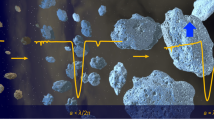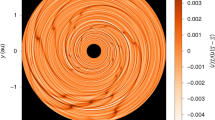Abstract
THERE seem to be two basic mechanisms by which interstellar grains can grow; the condensation of gaseous molecules (mostly of the CNO type) on to their surfaces and the coagulation on collision of individual grains. In general, as has been shown by Simons and Williams1, condensation leads to a more rapid growth rate than coagulation resulting from the thermal motion of the grains. If, however, relative motions can be set up within the grain population, then this increases the collision rate and so also increases the rate of growth by coagulation. Now, for small grains, the force on them from radiation pressure depends on a different function of the grain radius, a, than does the viscous drag generated by the ambient gas. (For simple models these functions are respectively a3 and a2.) Consequently, grains of differing sizes will be caused to move with different velocities through the ambient gas by radiation, the larger ones moving faster. This causes these grains to capture further grains by coagulation which in turn enhances their relative velocity even further. The purpose of the present communication is to show that this growth caused by radiation pressure coagulation is probably of the same order as that from gas atom condensation, and to point out an important consequence of this.
This is a preview of subscription content, access via your institution
Access options
Subscribe to this journal
Receive 51 print issues and online access
$199.00 per year
only $3.90 per issue
Buy this article
- Purchase on Springer Link
- Instant access to full article PDF
Prices may be subject to local taxes which are calculated during checkout
Similar content being viewed by others
References
Simons, S., and Williams, I. P., Astr. Space Sci., 32, 493 (1975).
Simons, S., and Williams, I. P., Astr. Space Sci. (in the press).
Greenberg, M., Nice Symposium on the Origin of the Solar System, 135 (CNRS, 1972).
Baines, M. J., Williams, I. P., and Asebiomo, A. S., Mon. Not. R. astr. Soc., 130, 63 (1965).
Lequeux, J., Nice Symposium on the Origin of the Solar System, 118 (CNRS, 1972).
Wickramasinghe, N. C., and Nandy, K., Rep. Prog. Phys., 35, 157 (1972).
Mednikov, E. P., Acoustic Coagulation and Precipitation of Aerosols (Consultants Bureau, New York, 1965).
Whittet, D. C. B., Daigawansa, I. J., Dickinson, P. M., Marsden, J. P., and Thomas, B., Mon. Not. R. astr. Soc., 175, 197 (1976).
Rowan-Robinson, G. M., Mon. Not. R. astr. Soc., 172, 109 (1975).
Author information
Authors and Affiliations
Rights and permissions
About this article
Cite this article
SIMONS, S., WILLIAMS, I. A plum-pudding model for interstellar grains. Nature 262, 273–274 (1976). https://doi.org/10.1038/262273a0
Received:
Accepted:
Published:
Issue Date:
DOI: https://doi.org/10.1038/262273a0
This article is cited by
-
Grain growth by radiation pressure induced coagulation
Astrophysics and Space Science (1980)
-
The role of induced charges in the accretion of charged dust grains
Astrophysics and Space Science (1978)
-
The charge distribution on interstellar grains?The effect of induced charge
Astrophysics and Space Science (1978)
Comments
By submitting a comment you agree to abide by our Terms and Community Guidelines. If you find something abusive or that does not comply with our terms or guidelines please flag it as inappropriate.



